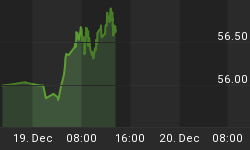Precious Metal share investors are faced with an acute dilemma at this time. On the one hand most precious metals stocks are obviously quite deeply oversold and not far above important support, which makes them attractive. On the other hand the dollar has just broken out above a significant resistance level and out of its long-term downtrend, although not by much, while both gold and copper have broken down from important chart patterns, gold having broken down from a symmetrical triangle of more than 5 months duration, although its break of its long-term uptrend is still marginal, and copper having clearly broken down from a 14-month bearish rising wedge pattern. Silver, however, has so far held up. Copper is mentioned here because its breakdown was rather dramatic and because the outlook for copper has implications for the course of the dollar.
Although many are expecting the dollar to do the decent thing and roll over and slump to new lows, there is considerable danger right now that it will do the opposite, that is the message being given by the copper and gold charts, as well as the dollar chart itself, of course. In addition a number of gold stock charts have suffered serious recent deterioration, notably Newmont Mining. Naturally it is attractive to buy stocks when they are cheaper, and precious metal stocks ARE cheap, compared to where they were late last year, but many of us know from experience that buying things when they are cheap doesn't do you much good if they get a whole lot cheaper.
The dilemma inherent in the current situation is neatly reflected by two charts, both of the HUI index - the 2-year chart and the 4-year chart. On the 2-year chart the HUI looks like an automatic buy, substantially oversold and on an important support level around last years' lows. However, things look very different on the four-year chart. The effect is partly psychological, because on the 4-year chart we can see the entire bull market run preceding the decline, which means that the scaling is different and we thus get a clear view of the potential downside. The ugly potential double-top that has formed over the past 18 months is evident on both charts, and on the 4-year chart the importance of the crucial support at and above 150 is obvious. If this support breaks we are looking at a bear market - failure of this level, which would be expected to be triggered by the dollar breaking strongly higher and gold (and silver) making substantial breaks of their long-term up trends, would be expected to lead to a rapid plunge to the 100 area, which is certainly possible, as although the market is close to its normal oversold limit, it can on occasion get much more oversold.


Looking on the bright side, if the dollar does roll over shortly and head lower, then we can expect the sector to pick up again and the HUI index to rally smartly back towards its earlier highs. However, those highs remain a major hurdle and traders will be lighten up automatically on any approach towards them.
At about this point you are probably thinking "Great - this guy is as confused as I am!" - but does this array of conflicting indications mean that there is no effective strategy available for dealing with the current situation? No, it doesn't, because the proximity of the market to key support means that a favourable risk/reward ratio can be defined and a strategy can be implemented to take advantage of it. Buyers at this time are aware of the oversold condition of the market, and are looking for a new intermediate uptrend to develop from about the current level but do not reasonably expect the market to take out the former highs in the 260 area in the foreseeable future, and will therefore look to take profits as this level is approached and await developments. Buying at the current level of about 175 and selling as the HUI hits 240 yields a 65 point gain. On the other hand current buyers will also be aware that should the key support at 150 fail, a plunge to the 100 area will be on the cards, so they should aim to hit the exits at, say, 145, with a calculated loss of 30 points on the index, assuming entry at about the current level. Therefore buyers at the current level will be attracted by this favourable risk reward ratio of a 65 point upside versus a 30 point downside. Obviously, should the market back off towards 150 in coming days, the risk/reward ratio will improve for new buyers. This kind of risk/reward analysis is commonplace in the options market, where complex strategies are employed to manage risk.
Potential buyers should go for stocks that, like the index, are close to key support levels, such as Glamis Gold and Kinross Gold (which appeared to have an intermediate reversal day yesterday), but not Newmont because of its negative volume pattern all this year. Stocks to avoid are those that breached important support levels on the recent decline, such as Crystallex and Freeport McMoran (which is vulnerable to continued weakness in the copper price), and as usual, the terminal looking South African stocks.















